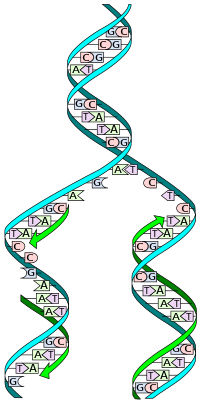
Photo from wikipedia
The hydrolytic loss of coding bases from cellular DNA is a common and unavoidable reaction. The resulting abasic sites can undergo β-elimination of the 3'-phosphoryl group to generate a strand… Click to show full abstract
The hydrolytic loss of coding bases from cellular DNA is a common and unavoidable reaction. The resulting abasic sites can undergo β-elimination of the 3'-phosphoryl group to generate a strand break with an electrophilic α,β-unsaturated aldehyde residue on the 3'-terminus. The work reported here provides evidence that the thiol residue of the cellular tripeptide glutathione rapidly adds to the alkenal group on the 3'-terminus of an AP-derived strand break. The resulting glutathionylated adduct is the only major cleavage product observed when β-elimination occurs at an AP site in the presence of glutathione. Formation of the glutathionylated cleavage product is reversible, but in the presence of physiological concentrations of glutathione, the adduct persists for days. Biochemical experiments provided evidence that the 3'-phosphodiesterase activity of the enzyme apurinic/apyrimidinic endonuclease (APE1) can remove the glutathionylated sugar remnant from an AP-derived strand break to generate the 3'OH residue required for repair via base excision or single-strand break repair pathways. The results suggest that a previously unrecognized 3'glutathionylated sugar remnant─and not the canonical α,β-unsaturated aldehyde end group─may be the true strand cleavage product arising from β-elimination at an abasic site in cellular DNA. This work introduces the 3'glutathionylated cleavage product as the major blocking group that must be trimmed to enable repair of abasic site-derived strand breaks by the base excision repair or single-strand break repair pathways.
Journal Title: Journal of the American Chemical Society
Year Published: 2022
Link to full text (if available)
Share on Social Media: Sign Up to like & get
recommendations!